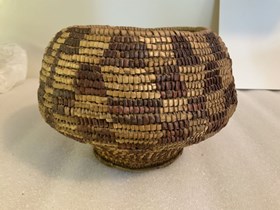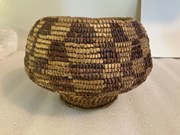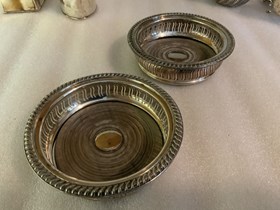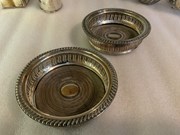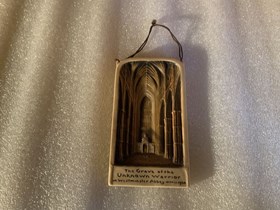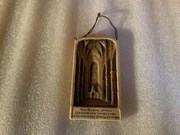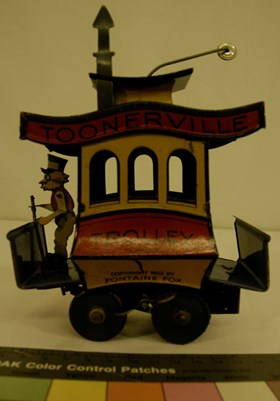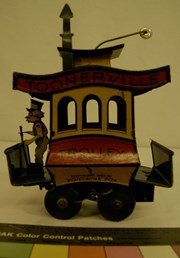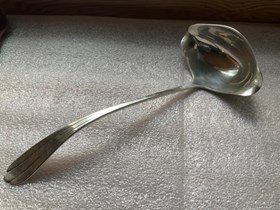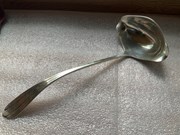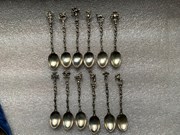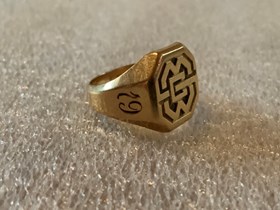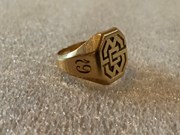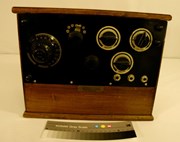Narrow Results By
Storage Basket
https://archives.whyte.org/en/permalink/artifact104.19.0020
- Date
- 1920
- Material
- grass
- Catalogue Number
- 104.19.0020
- Description
- A small basket that is made with natural and dyed straw woven in a checkerboard pattern. The basket has a pronounced shoulder which angles in to a narrower mouth. There is a coiled, flat, straw lid that fits into the opening.
1 image
- Title
- Storage Basket
- Date
- 1920
- Material
- grass
- Dimensions
- 17.0 cm
- Description
- A small basket that is made with natural and dyed straw woven in a checkerboard pattern. The basket has a pronounced shoulder which angles in to a narrower mouth. There is a coiled, flat, straw lid that fits into the opening.
- Credit
- Gift of Pearl Evelyn Moore, Banff, 1979
- Catalogue Number
- 104.19.0020
Images
This material is presented as originally created; it may contain outdated cultural descriptions and
potentially offensive content.
Read more.
- Date
- 1920 – 1920
- Material
- metal; wood
- Catalogue Number
- 104.20.0026 a,b
- Description
- A pair of round, flat bottomed, coasters with wooden bases and silver plated short vertical sides. The sides bulge slightly and flare out at the rim. The sides are pierced with a series of short double vertical lines alternating with an incised fern pattern. There is silver trim around the rim.
1 image
- Title
- Coaster
- Date
- 1920 – 1920
- Material
- metal; wood
- Dimensions
- 4.0 cm
- Description
- A pair of round, flat bottomed, coasters with wooden bases and silver plated short vertical sides. The sides bulge slightly and flare out at the rim. The sides are pierced with a series of short double vertical lines alternating with an incised fern pattern. There is silver trim around the rim.
- Subject
- households
- Credit
- Gift of Pearl Evelyn Moore, Banff, 1979
- Catalogue Number
- 104.20.0026 a,b
Images
This material is presented as originally created; it may contain outdated cultural descriptions and
potentially offensive content.
Read more.
- Date
- 1920 – 1920
- Material
- wax; metal; fibre
- Catalogue Number
- 107.01.0077
- Description
- A molded frame of a wax compound with a deep relief of a cathedral aisle lined with columns and arches from a floor to a high ceiling. There is a partition and doors at the end of a tall arched wall with a plaque and wreath on a tiled floor in front. The plaque is a yellowed ivory colour with blac…
1 image
- Title
- Plaque
- Date
- 1920 – 1920
- Material
- wax; metal; fibre
- Dimensions
- 8.5 x 15.0 cm
- Description
- A molded frame of a wax compound with a deep relief of a cathedral aisle lined with columns and arches from a floor to a high ceiling. There is a partition and doors at the end of a tall arched wall with a plaque and wreath on a tiled floor in front. The plaque is a yellowed ivory colour with black and brown staining to enhance details. The plaque hangs from a doubled brown twisted cord through small holes molded through each of the top corners. Carved below the relief is “The Grave of the Unknown Warrior in Westminster Abbey Nov 11 1920.” The back is stamped “Ivorex copyright in all countries Arthur Osborne, made in England.”
- Credit
- Gift of Pearl Evelyn Moore, Banff, 1979
- Catalogue Number
- 107.01.0077
Images
This material is presented as originally created; it may contain outdated cultural descriptions and
potentially offensive content.
Read more.
- Date
- 1922 – 1922
- Material
- metal
- Catalogue Number
- 104.03.0005
- Description
- A metal tag cut out in the shape of the number “22” with a metal S-ring at the top. The tag is stamped with “Canadian Nat'l Parks Dog Tax 108 -1922-”.
- Title
- Animal Tag
- Date
- 1922 – 1922
- Material
- metal
- Dimensions
- 3.0 x 0.2 x 3.0 cm
- Description
- A metal tag cut out in the shape of the number “22” with a metal S-ring at the top. The tag is stamped with “Canadian Nat'l Parks Dog Tax 108 -1922-”.
- Subject
- animals, dog
- households
- Credit
- Gift of Pearl Evelyn Moore, Banff, 1979
- Catalogue Number
- 104.03.0005
This material is presented as originally created; it may contain outdated cultural descriptions and
potentially offensive content.
Read more.
- Date
- 1922
- Material
- metal; paint
- Catalogue Number
- 108.05.1028
- Description
- A metal wind-up trolley that is made of lithographed tin and manufactured in Germany. Its name is the “TOONERVILLE TROLLEY” which was a well-known character in Fontaine Fox’s comic strip. The action of the toy simulates the action of the temperamental cartoon trolley. When the spring is wound the t…
1 image
- Title
- Trolley Toy
- Date
- 1922
- Material
- metal; paint
- Dimensions
- 9.0 x 12.5 cm
- Description
- A metal wind-up trolley that is made of lithographed tin and manufactured in Germany. Its name is the “TOONERVILLE TROLLEY” which was a well-known character in Fontaine Fox’s comic strip. The action of the toy simulates the action of the temperamental cartoon trolley. When the spring is wound the trolley moves forward about four feet. The wheels are offset on the axles so the whole trolley rocks back and forth as it moves along. After it moves forward four feet the trolley stops and the conductor, Dan the Skipper, moves his control stick around while the trolley makes noise. After a few seconds of pulling on the control rod, the Skipper gives it a good yank and the trolley moves forward again. There is a fixed key under the trolley on the viewer’s right-hand side from the front, with a wind-up spring mechanism of four different-sized (one large, 3 small) gears and three cogwheels under the trolley, a spring, plus one half-sized gear attached by two metal rods to the conductor. The trolley sits on the mechanism and the four wheels that turn on the axles., move the trolley backwards or and forwards. Both ends of the axle are soldered to a small ‘hubcap’ on each wheel. One of the wheels, the back wheel, on the viewer’s left from the front of the trolley, is severely off-centre (this may be for the rocking motion). The other three wheels have the axle going through the 3.0 cm diameter wheel at centre (1.50 cm); that puts the soldered ‘hubcap’ 1.0 cm radius from the edge, but on this wheel the axle goes through off-centre and from the ‘hubcap’ one side is at a radius 0.50 cm and the other is 1.30 cm. The trolley has a passenger car with three horseshoe arch-shaped windows cut out on both sides, the wavy roof has a separate yellow top (5.0x3.50w cm) with a grey smokestack (on the key side) on viewer’s left, and a wheel which turns on a narrow metal rod in the middle, viewer’s right. Simulated doors and windows are outlined in black on the front and back of the trolley; the blue floor is turned up at either end, creating an open platform, and the outside is red. The front has a bull’s eye outlined in black in the middle. At this end, the front, is the one-dimensional, cut-out conductor, “Dan the Skipper” wearing a blue and white conductor hat, black glasses, red vest, white shirt and beige trousers; he has a white beard and his face and hands are flesh-toned. He has moveable arms; the hand on the viewer’s left (key side), has a hole through which a thin metal rod is connected to the front of the trolley. His hand moves back and forth because the rod is attached to the mechanism underneath; the rod is attached to a gear that connects to the spring. His body is attached to another metal rod to a gear that also connects to the spring. The wavy roof has “TOONERVILLE” on the overhang, “TROLLEY”and “No. 280098” under the open windows, underneath that on the yellow part above the wheels “COPYRIGHT 1922 BY FONTAINE FOX” on both sides. Underneath the trolley’s red bottom platform is printed, viewer’s left (key side), “D.R.P. 257554” and across on viewer’s right side “G.M. 33967”. On the opposite side of the key, viewer’s left ,“PATENT APPLIED FOR.” and on viewer’s right, “MADE IN GERMANY”. A note: the trolley lists to the viewer’s left from the front; it may be partially due to the dent in the roof overhang, but it probably mostly due to the off-centre back left wheel.
- Subject
- households
- toys
- children
- Toonerville Trolley
- Credit
- Gift of Unknown, 2007
- Catalogue Number
- 108.05.1028
Images
This material is presented as originally created; it may contain outdated cultural descriptions and
potentially offensive content.
Read more.
- Date
- 1923
- Material
- metal
- Catalogue Number
- 104.20.0535
- Description
- Double lipped, deep ovoid ladle connected to slender, curved handle which terminates in tri-foliate design. Inscribed on back of handle "R/R + E ... 1898-1923", also stamped "Sterling... B09".
1 image
- Title
- Punch Ladle
- Date
- 1923
- Material
- metal
- Dimensions
- 7.0 x 14.5 x 34.5 cm
- Description
- Double lipped, deep ovoid ladle connected to slender, curved handle which terminates in tri-foliate design. Inscribed on back of handle "R/R + E ... 1898-1923", also stamped "Sterling... B09".
- Credit
- Gift of Catharine Robb Whyte, O. C., Banff, 1979
- Catalogue Number
- 104.20.0535
Images
This material is presented as originally created; it may contain outdated cultural descriptions and
potentially offensive content.
Read more.
- Date
- 1923
- Material
- fibre
- Catalogue Number
- 103.05.1202
- Description
- women’s one piece, navy bathing suit with 6 red strips at bottom of attached skirt, thick tight knit weave, tapered at waist, high slight V-neck, left side short shoulder strap, right side short shoulder straps meant to be fastened with missing button; right front corner has a stitched emblem of wo…
1 image
- Title
- Bathing Suit
- Date
- 1923
- Material
- fibre
- Dimensions
- 41.0 x 84.0 cm
- Description
- women’s one piece, navy bathing suit with 6 red strips at bottom of attached skirt, thick tight knit weave, tapered at waist, high slight V-neck, left side short shoulder strap, right side short shoulder straps meant to be fastened with missing button; right front corner has a stitched emblem of woman in red bathing suit and cap, diving with the word "JANTZEN" below her breast; inside label is black cloth with stitched "Jantzen c 1923/PAT Sept 26 1921/SWIMMING SUIT”.
- Subject
- households
- sports
- swimming
- Kidney
- MacAulay
- Credit
- Gift of Julie-Ann MacAulay, 2016
- Catalogue Number
- 103.05.1202
Images
This material is presented as originally created; it may contain outdated cultural descriptions and
potentially offensive content.
Read more.
Spoon Collection
https://archives.whyte.org/en/permalink/artifact104.20.0556%20a-l
- Date
- 1924
- Material
- metal
- Catalogue Number
- 104.20.0556 a-l
- Description
- Teaspoon size souvenir spoons, all with identical shafts in branch and leaf design with varying handle end decorations including peccary, gryphons, horse, crowns, cherub, Roman eagle, four have writing. Firenze, Forli, Siena and SPQR. Hallmarks on every spoon stamped "800" with hallmark resembling…
1 image
- Title
- Spoon Collection
- Date
- 1924
- Material
- metal
- Dimensions
- 1.1 x 1.8 x 12.2 cm
- Description
- Teaspoon size souvenir spoons, all with identical shafts in branch and leaf design with varying handle end decorations including peccary, gryphons, horse, crowns, cherub, Roman eagle, four have writing. Firenze, Forli, Siena and SPQR. Hallmarks on every spoon stamped "800" with hallmark resembling caduceus.
- Subject
- households
- animal
- horse
- eagle
- souvenir
- Credit
- Gift of Catharine Robb Whyte, O. C., Banff, 1979
- Catalogue Number
- 104.20.0556 a-l
Images
This material is presented as originally created; it may contain outdated cultural descriptions and
potentially offensive content.
Read more.
- Date
- 1924
- Material
- metal
- Catalogue Number
- 103.01.0118
- Description
- A heavy, gold ring with stylized letters "MCW" on top. Thick, flat band flares at front to become octagonal flat surface containing the signet. Band engraved "19" on one side of signet, and "24" on other, year 1924. Engraved under signet area "C Robb".
1 image
- Title
- Signet Ring
- Date
- 1924
- Material
- metal
- Dimensions
- 1.4 x 2.0 cm
- Description
- A heavy, gold ring with stylized letters "MCW" on top. Thick, flat band flares at front to become octagonal flat surface containing the signet. Band engraved "19" on one side of signet, and "24" on other, year 1924. Engraved under signet area "C Robb".
- Credit
- Gift of Catharine Robb Whyte, O. C., Banff, 1979
- Catalogue Number
- 103.01.0118
Images
This material is presented as originally created; it may contain outdated cultural descriptions and
potentially offensive content.
Read more.
Peanut Tube Radio
https://archives.whyte.org/en/permalink/artifact105.04.1016%20a-c
- Date
- 1924
- Material
- wood; metal; plastic; glass; fibre
- Catalogue Number
- 105.04.1016 a-c
- Description
- A peanut tube (three-tube) radio enclosed in a varnished brown wooden box/cabinet (a) with a hinged lid. The lid has two small metal screw eyes on each side of the inside (2.0cm from the corner) attaching it to the cabinet which has two metal hooks (2.0cm down from the front corner) screwed into pl…
1 image
- Title
- Peanut Tube Radio
- Date
- 1924
- Material
- wood; metal; plastic; glass; fibre
- Dimensions
- 26 x 18 x 32.5 cm
- Description
- A peanut tube (three-tube) radio enclosed in a varnished brown wooden box/cabinet (a) with a hinged lid. The lid has two small metal screw eyes on each side of the inside (2.0cm from the corner) attaching it to the cabinet which has two metal hooks (2.0cm down from the front corner) screwed into place on both sides. These are used to close the lid securely to the main cabinet. A paper diagram of the circuitry board is tacked to the obverse side of the lid with six metal thumbtacks. The diagram outlines the blueprint of the radio (b), which is separate from the cabinet; the radio slides out of the front from two grooves cut into the sides of the cabinet. The cabinet has two holes bored into the back to attach it to a wall. The front of the radio has a plastic panel secured in place to the base, which is a flat piece of wood, by the dials etc. and four screws on the bottom. Extreme left in the top and bottom corner are two small black plastic knobs; the top knob is the antennae, the bottom is the ground knob. In between these to the middle left is a large plastic knob, black with degrees marked in white, adjustable control (0 increasing by 10’s to a 100 degrees) for station tuning; the small knob in centre (starting at 0 increasing by 5 degrees to 2, then 3, both left and right) is for fine tuning. Next, to the top right is an adjustable black knob with a bent metal contact piece attached; it moves left and right moving to make contact with five metal posts used for switching to different radio bands; two metal posts, one at either end, are used to keep the metal contact piece within the five contact points radius. Below this is a plain black plastic adjustable knob used for sensitivity control for the strength of radio station waves. This goes in and out, further and closer, (it is attached to wires covered with a textile). To the right of these are three black plastic knobs adjustable rheostats (that control the filaments of the three tubes inside (R215-A Vacuum tube); this is the volume control. Three nuts (jack has a thread on it to keep in place) are for jacks for headphone output. Jack 3, closest to the edge of the radio, also controls the switch to the speaker (if you want to have a speaker hooked up to loudspeaker). There are two wires attached different colours; they have a sleeve on the corners so it doesn’t short-circuit.The headphones (c) are hard plastic earpieces (6 cm. in diametre); one has a metal back with “FROST (F)ONES NO. 161 1000” , and three screws underneath the lettering; the other is black hard Bakelite plastic with “National” written in script ,“ELECTRIC” in the tail of the L, underneath that “OHMS 100C SINGLE”, two screws and nuts attaching two-fibre covered wires on either side that connect to the plastic and metal jack plug, “MNFD. BY THE NATIONAL ELECTRIC HEATING COMPANY LIMITED TORONTO CANADA”. Each earpiece has a metal piece attached by rivets to each side allowing it to move. The two-band fibre-covered headpiece is connected to the metal piece by two metal wires. The two fibre-cover wires extending from the earphones are joined and covered with a black cord wound around until it forms a loop which is knotted to close. Two plugs that fit into the jack attachment BARKEKLEW SERIESPAT. PENDING NUMBERS 1,2,3,4, negative on the left side and positive on the right making 8 hole plugs, 2 screws in the place attaching to the metal jack that plugs into the radio.Blueprint hand drawn for back.
- Subject
- households
- furniture
- entertainment
- Credit
- Gift of Lorne Cooley, Banff, 2008
- Catalogue Number
- 105.04.1016 a-c
Images
This material is presented as originally created; it may contain outdated cultural descriptions and
potentially offensive content.
Read more.

